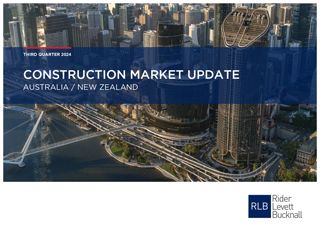According to the Rider Levett Bucknall (RLB) 3rd Quarter 2024 Construction Market Update for Australia and New Zealand, the construction industry in Australia is currently navigating a multi-faceted and challenging landscape.
Ewen McDonald, Director of RLB Oceania Research & Development said, “Skilled labour shortages are a significant concern, driving up wage costs and creating intense competition for available workers.”
Strong pressure on project budgets and timelines
“This issue is compounded by rising material costs, influenced by global supply-chain disruptions and increased transportation expenses. These factors are exerting considerable pressure on project budgets and timelines,” he added.
Government investment in infrastructure and major projects continues to be a primary driver of market activity across various regions. This investment is crucial for sustaining demand and fuelling economic growth.
Public and private sector projects competing for resources
However, it also contributes to the heightened competition for resources, as both public and private sector projects vie for the same pool of skilled labour and materials. While some cities, such as Perth and Melbourne, are experiencing a degree of pricing stabilisation for certain project types, market conditions remain challenging overall.
RLB’s Construction Update shows cost pressures most evident in Sydney
According to RLB’s Construction Update, persistent cost escalation pressures are evident, particularly in areas like Sydney, where strong demand for labour and materials, coupled with supply chain issues and global inflationary trends, continue to drive construction costs up.
Options limited for developers and asset owners in Adelaide and Darwin
In cities such as Adelaide and Darwin, the lack of competition among tier one contractors and subcontractors is inflating project costs and limiting options for developers and asset owners. This situation is exacerbated by the scarcity of skilled labour, which is driving contractors to be more selective with projects and seek higher margins.
Rising construction costs in Brisbane impacting private sector
In Brisbane, rising construction costs—driven by multiple factors—continue to make it increasingly challenging for the private sector to maintain project viability.
With the upcoming Queensland state election in Q4, there may be changes to the forecast pipeline of works into 2025 for cities including Brisbane, potentially creating some opportunities.
Australia’s construction markets are experiencing diverse conditions, with common challenges including skilled labour shortages, rising costs, and strong demand influencing project pricing and market dynamics.
KEY INSIGHTS
1. Labour and Cost Pressures
- Across all regions, skilled labour shortages are driving up wage costs and creating competition for available workers
- Rising material costs, influenced by global supply chain issues and increased transportation costs, are adding to overall project expenses
2. Regional Variations
- Adelaide: The market remains resilient with potential upward pressure on project pricing due to strong demand and limited competition among contractors
- Brisbane: Escalating construction costs are making private projects unviable. Government-funded projects are keeping tier one contractors busy. However, the upcoming state government election may influence future project opportunities
- Canberra: Positive outlook with strong government commitment to major projects, but challenges include skilled labour shortages and rising costs
- Darwin: Despite some material price stabilisation, labour shortages and high demand continue to drive market volatility and cost increases
- Gold Coast: Government construction programs are leading to capacity challenges and cost pressures, with a two-speed market emerging between high-value and lower-value projects
- Melbourne: Pricing stabilisation continues but concerns over Construction, Forestry and Maritime Employees Union (CFMEU) activities and a mixed pipeline of new projects suggest potential market slowdown
- Perth: Pricing has stabilised for low-risk projects, but rising transportation costs for imported materials are expected to push prices up. The market operates near capacity with low unemployment
- Sydney: Persistent cost escalation pressures are driven by strong demand for labour and materials, compounded by supply chain issues and inflationary pressures
- Townsville: Trade pricing is driven by major projects, impacting contractors and private developments. The upcoming state government election may influence project feasibility and competitiveness
Mr McDonald concluded, “While pricing is stabilising in some regions, overall market conditions remain challenging due to labour shortages, rising costs, and strong demand. The construction industry is likely to continue grappling with these pressures, though extent and impact will vary across regions.”
RLB TENDER PRICE INDEX ANNUAL % UPLIFTS AS AT Q3 2024
| AUSTRALIA | 2023 | 2024 f | 2025 f | 2026 f | 2027 f | 2028 f |
|---|---|---|---|---|---|---|
| ADELAIDE | 5.1 | 6.5 | 5.0 | 4.5 | 4.0 | 3.5 |
| BRISBANE | 8.0 | 7.2 | 5.6 | 5.1 | 5.1 | 5.1 |
| CANBERRA | 4.5 | 4.0 | 3.75 | 3.5 | 3.0 | 3.0 |
| DARWIN | 5.5 | 5.5 | 5.0 | 4.5 | 4.0 | 4.0 |
| GOLD COAST | 10.5 | 7.5 | 5.0 | 5.0 | 5.0 | 5.0 |
| MELBOURNE | 8.0 | 5.0 | 4.0 | 3.5 | 3.5 | 3.5 |
| PERTH | 5.8 | 5.2 | 4.9 | 4.5 | 4.0 | 3.7 |
| SYDNEY | 6.0 | 5.5 | 4.5 | 3.5 | 3.5 | 3.5 |
| TOWNSVILLE | 5.0 | 7.0 | 6.0 | 5.0 | 4.0 | 4.0 |
FURTHER INFORMATION:



